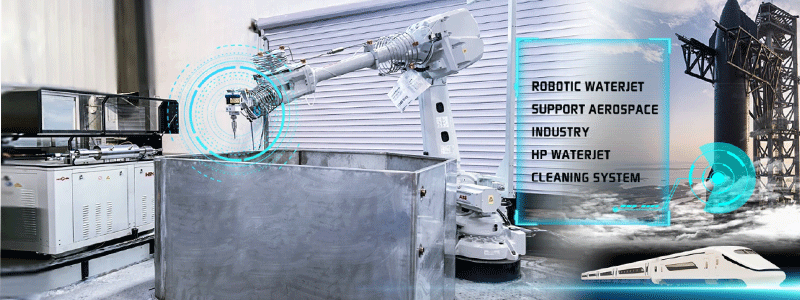What is water jet cleaning technology ?
Water jet cleaning technology have other often overlooked uses such as cleaning, degreasing, and stripping. When surface contaminants need to be removed, it offers a unique solution. In these applications, sometimes referred to as water jet stripping or water jet blasting, the goal is the removal of all grease and old coatings with no removal of the substrate material.
There are many benefits to using water jet systems for these applications. When using water systems, solvents and other harsh chemicals are not required as the power of water removes the material. When a water jet cutting head is adapted with a cleaning swivel and attached to a robotic arm, only the surfaces requiring cleaning are traced. The focused pressurized water stream replaces the need for manual cleaning and the use of corrosive chemicals. All of these processes take place in a purpose built chamber with various fixtures used for parts hold down.
Whats the robotic water jet cleaning cells?
Water jet robotic cleaning cells are automated systems that use high-pressure water jets to clean surfaces or remove contaminants. These systems are commonly used in industrial settings, such as manufacturing plants or assembly lines, where there is a need for efficient and precise cleaning of parts or equipment.
It is typically consist of a robotic arm or multiple robotic arms equipped with specialized nozzles that emit high-pressure water jets. These nozzles can be adjusted to control the pressure and spray pattern of the water, allowing for targeted and thorough cleaning.
The robotic arm(s) are programmed to move along a predetermined path, ensuring that all areas of the surface to be cleaned are covered. They can also be equipped with sensors or cameras to detect and adapt to the shape or contours of the object being cleaned, ensuring optimal cleaning performance.
whats the advantages of water jet cleaning technology?
Water jet cleaning cells offer several advantages over traditional cleaning methods. Firstly, they provide a non-contact cleaning process, which eliminates the risk of damage to delicate or sensitive surfaces. Secondly, the high-pressure water jets can effectively remove stubborn contaminants, such as grease, oil, or paint, without the need for harsh chemicals. This makes water jet cleaning cells environmentally friendly and reduces the need for hazardous cleaning agents.
Additionally, water jet cleaning cells can be highly efficient and time-saving. The automation provided by the robotic arm(s) allows for continuous operation and consistent cleaning quality. This can result in increased productivity and cost savings for industrial applications.
It's worth noting that water jet cleaning cells can be customized to meet specific cleaning requirements. The pressure, flow rate, and spray pattern of the water jets can be adjusted based on the type of surface or contaminant being cleaned. Moreover, additional features such as drying mechanisms or filtration systems can be integrated into the cleaning cells to further enhance their effectiveness.
Overall, water jet robotic cleaning cells offer a versatile and efficient solution for industrial cleaning applications, combining automation, precision, and environmentally friendly cleaning methods.
In which industries is water jet cleaning mainly used?

Manufacturing: used to clean and treat parts and workpieces in manufacturing processes. It can remove welding residues, cut paint and coatings, remove dirt from production processes, and more.
Automobile industry: can be used for cleaning and purifying automobile parts, such as engine parts, chassis parts and painted parts. It removes grease, stains and other contaminants, leaving parts in a clean condition.
Aerospace industry: In the aerospace industry, it can be used to clean aircraft parts, engine components and spacecraft components. It removes corrosives, coatings and other contaminants, ensuring part reliability and performance.
Electronic manufacturing industry: it can be used for cleaning electronic components and circuit boards. It removes soldering residue, oxide layers and other contaminants to ensure the proper operation of electronic equipment.
Medical Equipment: In the medical industry, it can be used to clean and disinfect medical equipment, surgical instruments, and implants. It can effectively remove bacteria, viruses and other microorganisms to ensure the hygiene and safety of equipment.
Textile industry: Water jet cleaning can be used for cleaning and processing of textiles, such as cleaning fabrics, dyeing and ironing processes. It removes pigments, dyes and other contaminants, keeping textiles clean and of high quality.
These are just some examples of water jet cleaning applications. In fact, water jet cleaning is also widely used in many other industries and fields because it provides efficient, environmentally friendly and precise cleaning solutions.
What are the specific applications in aerospace?
Propulsion System Cleaning: A spacecraft’s propulsion system includes engines and associated fuel lines. These propulsion systems need to be cleaned and maintained before or after a space mission. Water jet cleaning units can use high-pressure water jets to clean residues within engines and pipes. This helps ensure proper operation and performance of the propulsion system.
Fuel tank cleaning: Spacecraft fuel tanks require regular cleaning and maintenance to ensure the quality and safety of the fuel. Waterjet cleaning units use high-pressure water jets to clean deposits, dirt and other contaminants from the inside of fuel tanks. This is important to ensure fuel system reliability and safety.
Spacecraft surface cleaning: Spacecraft are exposed to various extreme environments in space, such as cosmic dust, tiny meteorite fragments, etc. These particles can leave dirt or contamination on the surface of the spacecraft.
Aerodynamic cleaning: The shape and surface of the spacecraft have an important impact on aerodynamic performance.
These are some of the unique applications in aerospace. Waterjet cleaning provides an efficient, precise and environmentally friendly cleaning method that is critical to ensuring the reliability, performance and safety of spacecraft.
 wwaterjet
wwaterjet